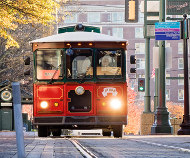Article from: www.thenewspaper.com/news/63/6327.asp
10/27/2017
Report: Billions In Subsidies Fail To Save Transit
Cato Institute report predicts mass transit will largely disappear by the year 2032.
 The $1.1 trillion in federal, state and local government dollars handed to public transit systems over the past four decades has failed to make traveling by bus, rail or trolley any more popular. That was the finding of a Cato Institute report released on Tuesday examining the history of transit in the United States. The think tank found that the annual $50 billion cash infusion these systems currently receive has resulted in a drop, not an increase, in ridership.
The $1.1 trillion in federal, state and local government dollars handed to public transit systems over the past four decades has failed to make traveling by bus, rail or trolley any more popular. That was the finding of a Cato Institute report released on Tuesday examining the history of transit in the United States. The think tank found that the annual $50 billion cash infusion these systems currently receive has resulted in a drop, not an increase, in ridership.
Ridership declined from 98 trips per urban resident in 1956 to 42 trips by 2014. The greatest share of urban transit travel is found in New York, where transit represents 58 percent of central city travel, 40 percent in Washington, DC, 36 percent in San Francisco and 34 percent in Boston. But when the extended urban area is factored in, transit is 11 percent, 4 percent, 5 percent and 3 percent of total travel in the urban area, respectively.
"The transit industry has persuaded many that public transit relieves congestion, saves energy, reduces pollution, is a vital part of urban economies, and helps low-income people," Cato transportation analyst Randal O'Toole wrote. "In fact, in the vast majority of urban areas in the United States, none of these things are true."
The cost of operating transit systems continues to rise as ridership continues to decline. Transit agencies spent $1.14 per passenger mile in 2015, compared to 60 cents for Amtrak, the 26 cents motorists spend on driving and the 16 cents spent on commercial airline travel. Each of those transit miles were subsidized with 87 cents in taxpayer cash. With politicians directing those subsidies, transit priorities emphasize shiny new construction over maintenance, creating catastrophic problems in the aging New York and Washington metro systems, the report found.
Along with unsustainable budgets, transit systems also face exploding pension liabilities for former employees. In Boston, for example, the unfunded obligations for pension and health care amount to $3.5 billion in a system with annual operating expenses of $1.7 billion. Washington and New York's transit systems likewise find themselves underwater, and they may not last much longer. The report suggests that the idea of transit has become obsolete, and that Uber and Lyft could be the final nail in transit's coffin.
"Some predict that within five years those ride-hailing services will begin using driverless cars, which will reduce their fares to rates competitive with transit, but with far more convenient service," O'Toole wrote. "This makes it likely that outside of a few very dense areas, such as New York City, transit will be extinct by the year 2030, leaving behind a huge burden of debt and unfunded obligations to former transit employees."
Lyft is already trialing a shuttle service that competes directly with public transit, but transit agencies have responded to innovation by seeking greater subsidies. The report recommends replacing the subsidies with transportation voucher assistance for low-income residents that could be used with any service.
"Whether or not shared driverless cars will put transit agencies out of business in the next decade, those agencies should stop wasting money on expensive and noncompetitive transit services and focus on providing basic, cost-effective services for those who need transit the most, while putting their economic houses in order by reducing maintenance backlogs, debts, and unfunded obligations," O'Toole concluded.
A copy of the report is available in a 250k PDF file at the source link below.
Source: The Coming Transit Apocalypse (Cato Institute, 10/25/2017)
Permanent Link for this item
Return to Front Page
 The $1.1 trillion in federal, state and local government dollars handed to public transit systems over the past four decades has failed to make traveling by bus, rail or trolley any more popular. That was the finding of a Cato Institute report released on Tuesday examining the history of transit in the United States. The think tank found that the annual $50 billion cash infusion these systems currently receive has resulted in a drop, not an increase, in ridership.
The $1.1 trillion in federal, state and local government dollars handed to public transit systems over the past four decades has failed to make traveling by bus, rail or trolley any more popular. That was the finding of a Cato Institute report released on Tuesday examining the history of transit in the United States. The think tank found that the annual $50 billion cash infusion these systems currently receive has resulted in a drop, not an increase, in ridership.